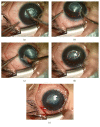Active Pedicle Epithelial Flap Transposition Combined with Amniotic Membrane Transplantation for Treatment of Nonhealing Corneal Ulcers
- PMID: 27830086
- PMCID: PMC5086501
- DOI: 10.1155/2016/5742346
Active Pedicle Epithelial Flap Transposition Combined with Amniotic Membrane Transplantation for Treatment of Nonhealing Corneal Ulcers
Abstract
Introduction. The objective was to evaluate the efficacy of active pedicle epithelial flap transposition combined with amniotic membrane transplantation (AMT) in treating nonhealing corneal ulcers. Material and Methods. Eleven patients (11 eyes) with nonhealing corneal ulcer who underwent the combined surgery were included. Postoperatively, ulcer healing time was detected by corneal fluorescein staining. Visual acuity, intraocular pressure, surgical complications, and recurrence were recorded. Corneal status was inspected by the laser scanning confocal microscopy and anterior segment optical coherence tomography (AS-OCT). Results. The primary diseases were herpes simplex keratitis (8 eyes), corneal graft ulcer (2 eyes), and Stevens-Johnson syndrome (1 eye). All epithelial flaps were intact following surgery, without shedding or displacement. Mean ulcer healing time was 10.8 ± 3.1 days, with a healing rate of 91%. Vision significantly improved from 1.70 to 0.82 log MAR (P = 0.001). A significant decrease in inflammatory cell infiltration and corneal stromal edema was revealed 2 months postoperatively by confocal microscopy and AS-OCT. Corneal ulcer recurred in 1 eye. None of the patients developed major complications. Conclusion. Active pedicle epithelial flap transposition combined with AMT is a simple and effective treatment for nonhealing corneal ulcers.
Figures




Similar articles
-
[Deep anterior lamellar keratoplasty combined with antiviral therapy in the treatment of severe herpes necrotizing stromal keratitis].Zhonghua Yan Ke Za Zhi. 2018 Feb 11;54(2):97-104. doi: 10.3760/cma.j.issn.0412-4081.2018.02.006. Zhonghua Yan Ke Za Zhi. 2018. PMID: 29429293 Chinese.
-
[Multilayer amniotic membrane transplantation for treatment of necrotizing herpes simplex stromal keratitis].Zhonghua Yan Ke Za Zhi. 2005 Dec;41(12):1107-11. Zhonghua Yan Ke Za Zhi. 2005. PMID: 16409765 Chinese.
-
[Treatment of severe marginal ulcerative keratitis by glucocorticoids combined with amniotic membrane transplantation].Zhonghua Yan Ke Za Zhi. 2025 Feb 14;61(2):125-130. doi: 10.3760/cma.j.cn112142-20240710-00297. Zhonghua Yan Ke Za Zhi. 2025. PMID: 39939007 Chinese.
-
[New diagnostic methods for imaging the anterior segment of the eye to enable treatment modalities selection].Nippon Ganka Gakkai Zasshi. 2011 Mar;115(3):297-322; discussion 323. Nippon Ganka Gakkai Zasshi. 2011. PMID: 21476312 Review. Japanese.
-
Amniotic membrane transplantation for managing dry eye and neurotrophic keratitis.Taiwan J Ophthalmol. 2020 Mar 4;10(1):13-21. doi: 10.4103/tjo.tjo_5_20. eCollection 2020 Jan-Mar. Taiwan J Ophthalmol. 2020. PMID: 32309119 Free PMC article. Review.
Cited by
-
Experimental study of trabecular tissue repair for corneal defect in rabbits.Int J Ophthalmol. 2020 Sep 18;13(9):1356-1360. doi: 10.18240/ijo.2020.09.03. eCollection 2020. Int J Ophthalmol. 2020. PMID: 32953571 Free PMC article.
-
Visual Acuity and Number of Amniotic Membrane Layers as Indicators of Efficacy in Amniotic Membrane Transplantation for Corneal Ulcers: A Multicenter Study.J Clin Med. 2021 Jul 22;10(15):3234. doi: 10.3390/jcm10153234. J Clin Med. 2021. PMID: 34362018 Free PMC article.
References
-
- Prabhasawat P., Tesavibul N., Komolsuradej W. Single and multilayer amniotic membrane transplantation for persistent corneal epithelial defect with and without stromal thinning and perforation. British Journal of Ophthalmology. 2001;85(12):1455–1463. doi: 10.1136/bjo.85.12.1455. - DOI - PMC - PubMed
LinkOut - more resources
Full Text Sources
Other Literature Sources
Research Materials

